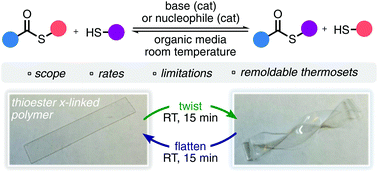当前位置:
X-MOL 学术
›
Polym. Chem.
›
论文详情
Our official English website, www.x-mol.net, welcomes your
feedback! (Note: you will need to create a separate account there.)
A user's guide to the thiol-thioester exchange in organic media: scope, limitations, and applications in material science†
Polymer Chemistry ( IF 4.1 ) Pub Date : 2018-08-14 00:00:00 , DOI: 10.1039/c8py01031e Brady T. Worrell 1, 2, 3, 4 , Sudheendran Mavila 1, 2, 3, 4 , Chen Wang 1, 2, 3, 4 , Taylor M. Kontour 1, 2, 3, 4 , Chern-Hooi Lim 1, 2, 3, 4 , Matthew K. McBride 1, 2, 3, 4 , Charles B. Musgrave 1, 2, 3, 4 , Richard Shoemaker 1, 2, 3, 4 , Christopher N. Bowman 1, 2, 3, 4, 5
Polymer Chemistry ( IF 4.1 ) Pub Date : 2018-08-14 00:00:00 , DOI: 10.1039/c8py01031e Brady T. Worrell 1, 2, 3, 4 , Sudheendran Mavila 1, 2, 3, 4 , Chen Wang 1, 2, 3, 4 , Taylor M. Kontour 1, 2, 3, 4 , Chern-Hooi Lim 1, 2, 3, 4 , Matthew K. McBride 1, 2, 3, 4 , Charles B. Musgrave 1, 2, 3, 4 , Richard Shoemaker 1, 2, 3, 4 , Christopher N. Bowman 1, 2, 3, 4, 5
Affiliation

|
The exchange of thiolates and thiols has long been held as a nearly ideal reaction in dynamic covalent chemistry. The ability for the reaction to proceed smoothly in neutral aqueous media has propelled its widespread use in biochemistry, however, far fewer applications and studies have been directed towards its use in material science which primarily is performed in organic media. Herein, we present the exploration of this dynamic exchange in both small molecule and polymer settings with a wide sampling of thiols, thioesters, organic bases, and nucleophilic catalysts in various organic solvents. Effects of the character of the thiol and thioester, pKa or nucleophilicity of the catalyst, and heat on the reaction were investigated. The mechanism regarding the previously unexplored effectiveness of nucelophilic catalysts, such as quinuclidine or DABCO, to affect the thiol-thioester exchange was also explored. Finally, the use of the thiol-thioester exchange in a network polymer to reduce applied stresses or change shape of the material following polymerization was shown and the ability of basic and nucleophilic catalysts to promote these effects were benchmarked. The influence of polarity in these networks was also explored, with the rate of exchange shown to be easily tuned by the addition of diluents with varying polarities. Presented here is a so-called “user's guide” to the thiol-thioester exchange; we hope that this guide is instructive to practitioners in the field of material science which seek to utilize the thiol-thioester exchange in both linear and network polymers.
中文翻译:

有机介质中硫醇-硫酯交换的用户指南:材料科学的范围,局限性和应用†
长期以来,硫醇盐和硫醇的交换一直是动态共价化学中近乎理想的反应。反应在中性水性介质中平稳进行的能力推动了其在生物化学中的广泛应用,然而,很少有应用和研究针对其在主要在有机介质中进行的材料科学中的使用。在本文中,我们介绍了在小分子和聚合物环境中进行这种动态交换的探索,并在各种有机溶剂中对硫醇,硫酯,有机碱和亲核催化剂进行了广泛采样。硫醇和硫酯特性的影响,p K a研究了催化剂的亲核性或亲核性,以及反应中的热量。还研究了有关嗜酸性催化剂(如奎尼丁或DABCO)以前无法探索的影响硫醇-硫酯交换效果的机理。最后,显示了在网络聚合物中使用硫醇-硫酯交换物以降低聚合后施加的应力或改变材料的形状,并且对碱性和亲核催化剂促进这些作用的能力进行了基准测试。还研究了极性在这些网络中的影响,通过添加极性不同的稀释剂可以很容易地调节交换速率。这里介绍的是硫醇-硫酯交换的所谓“用户指南”。
更新日期:2018-08-14
中文翻译:

有机介质中硫醇-硫酯交换的用户指南:材料科学的范围,局限性和应用†
长期以来,硫醇盐和硫醇的交换一直是动态共价化学中近乎理想的反应。反应在中性水性介质中平稳进行的能力推动了其在生物化学中的广泛应用,然而,很少有应用和研究针对其在主要在有机介质中进行的材料科学中的使用。在本文中,我们介绍了在小分子和聚合物环境中进行这种动态交换的探索,并在各种有机溶剂中对硫醇,硫酯,有机碱和亲核催化剂进行了广泛采样。硫醇和硫酯特性的影响,p K a研究了催化剂的亲核性或亲核性,以及反应中的热量。还研究了有关嗜酸性催化剂(如奎尼丁或DABCO)以前无法探索的影响硫醇-硫酯交换效果的机理。最后,显示了在网络聚合物中使用硫醇-硫酯交换物以降低聚合后施加的应力或改变材料的形状,并且对碱性和亲核催化剂促进这些作用的能力进行了基准测试。还研究了极性在这些网络中的影响,通过添加极性不同的稀释剂可以很容易地调节交换速率。这里介绍的是硫醇-硫酯交换的所谓“用户指南”。











































 京公网安备 11010802027423号
京公网安备 11010802027423号